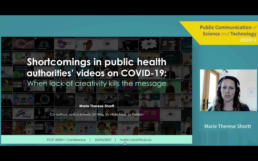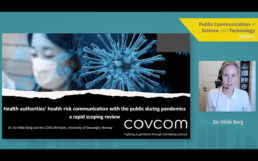Shortt presents at PCST 2020+1 Conference
On 26th May 2021, our Postdoc Marie Therese Shortt presented insights from 'Shortcomings in public health authorities' videos on COVID-19: When lack of creativity kills the message' at the Public Communication of Science and Technology Conference 2020+1.
The programme for the session
Theme: Science communication, COVID and controversies (Session H: 15:15-16:30 BST)
Chair: Jan Riise
| Public Perception, Myths, and Communication in Turkey During COVID-19 Pandemic | Sevinc Gelmez-Burakgazi | Turkey |
| Enabling decision-relevant debates about human genome editing | Nicole Krause | United States |
| Shortcomings in public health authorities' videos on COVID-19: When lack of creativity kills the message | Marie Therese Shortt | Norway |
| Public engagement with Science among Religious Minorities: Lessons from COVID-19 |
Abstract and information
Individual paper
Shortcomings in public health authorities' videos on COVID-19: When lack of creativity kills the message
Author: Marie Therese Shortt
University of Stavanger, Norway
Video communication has played a key role in relaying important and complex information on the COVID-19 pandemic to the general public. The aim of the study was to compare videos on COVID-19 published by Norwegian Health Authorities, WHO and on YouTube as a first step towards identifying whether videos by health authorities measure up to contemporary creative practices and video consumer behaviour on YouTube. Through structured search on YouTube, we found that Norwegian health authorities have published 26 (unique) videos to relay information on COVID-19, and the WHO, of which Norway is a member, a total of 29 videos. Press conferences, live videos and interviews by external media outlets were not included. A content analysis comparing these 55 videos to the 27 most viewed videos on COVID-19 on YouTube in video and channel data, video category, and creative presentation means, demonstrates a wide creative gap between videos created by the healthcare authorities and contemporary practices utilised in the creative media industry. Health authorities and WHO’s COVID-19 videos appear out of sync with popular online culture. A more reflective approach to creative communication can help increase the uptake, recall and reach of audio-visual communication on pandemics by public healthcare authorities. The study suggests future research areas to grow the evidence relating to creative choices and how they impact reach, viewers’ behaviour and trust.
Co-authors: Ionica Smeets
Leiden University, Netherlands
Siri Wiig
Siv Hilde Berg
Jo Røislien
Centre for Resilience in Healthcare, Faculty of Health Sciences, University of Stavanger, Norway
Berg presents at PCST 2020+1 Conference
On 24th May 2021, our Postdoc Siv Hilde Berg presented insights from her paper 'Health authorities' health risk communication with the public during pandemics: a rapid scoping review' at the Public Communication of Science and Technology Conference 2020+1.
The programme for the session
Theme: Science communication & COVID (Session A: 13:45 – 15:00 BST)
Chair: Ana Claudia Nepote
| Public understanding of the mathematical aspects of the COVID-19 pandemic | Ayelet Baram-Tsabari | Israel |
| Health authorities' health risk communication with the public during pandemics: a rapid scoping review | Siv Hilde Berg | Norway |
| Rapid reaction: Science Media Center Germany and its response to the COVID-19 outbreak | Irene Broer | Germany |
| How citizens make sense of Covid-19 and the practice of communicating science | Frank Kupper | Netherlands |
| Narrative analysis about facemask wearing at the COVID-19 time: perceptions of a basic tool with significant socio-cultural implications | Lucia Martinelli | Italy |
Abstract and information
Individual paper
Health authorities' health risk communication with the public during pandemics: a rapid scoping review
Author: Siv Hilde Berg
Centre for Resilience in Healthcare, Faculty of Health Sciences, University of Stavanger, Norway
Background: Scientific insights from the H1N1 Swine flu pandemic and the recent coronavirus pandemic COVID-19 provide an opportunity to get insight into the role of health authorities" various ways of communicating health risk information to the public. Hence, we aimed to synthesise the existing evidence regarding different modes of communication used by health authorities in health risk communication with the public during a pandemic.
Methods: We conducted a rapid scoping review. MEDLINE and EMBASE were searched for publications in English from January 2009- through October 2020, covering both the H1N1 pandemic as well as the response phase during the COVID-19 pandemic.
Results:The search resulted in 1440 records, of which 48 studies met our eligibility criteria. The included studies were analysed in a content analysis.
Conclusion: The identified studies on social media focused mainly on engagement. There is a lack of studies investigating the effect of health authorities" videos and messages on social media platforms and self-protective behaviour. More studies with RCT design are needed across the fields of health risk communication and media studies (including visual communication, creative communication, video, digital marketing) at a time when online digital communication is central in reaching the public.
Co-authors:
Jane O'Hara
School of Healthcare, Faculty of Medicine & Health, University of Leeds, UK., United Kingdom
Henriette Thune
Faculty of Health Sciences, University of Stavanger, Norway, Norway
Siri Wiig
Marie Therese Shortt
Kolbjørn K. Brønnick
Centre for Resilience in Healthcare, Faculty of Health Sciences, University of Stavanger, Norway
https://www.abdn.ac.uk/events/conferences/pcst/


